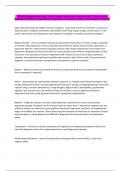NR546 Psychopharmacology Week 5 Exam | Questions & Answers (100 %Score) Latest
Updated 2024/2025 Comprehensive Questions A+ Graded Answers | With Expert Solutions
Major Depressive Disorder (MDD) common symptoms - depressed mood, loss of interest or pleasure in
daily activities, irritability, withdrawal, and problems with sleep eating, energy, concentration, or self
worth. Clients with severe depression may experience thoughts of suicide or psychotic symptoms.
Bipolar Disorder - chronic condition characterized by extreme fluctuations in mood, energy, and ability
to function. May experience recurrent episodes and remissions. Moods may be manic, hypomanic, or
depressed. May be a mixed mood or psychotic features. Most bipolar depression clients experience
depression symptoms and may have only one manic episode in their lifetime. Diagnosed when a client
has one or more episodes of mania or hypomania with a history of one or more major depressive
episodes. Associated with significant morbidity and mortality. High risk for suicide. Correct and early
diagnosis is essential to prevent complications and maximize treatment response.
Bipolar I - Requires at least one episode of mania for at least one week (or any duration if hospitalized
due to symptoms is required).
Mania - characterized by a persistently elevated, expansive, or irritable mood. Related symptoms may
include inflated self esteem, increased goal directed activity or energy, including grandiosity, decreased
need for sleep, excessive talkativeness, racing thoughts, flight of ideas, distractibility, psychomotor
agitation, and a propensity to be involved in high risk activities. Leads to significant functional
impairment and may include psychotic features or necessitate hospitalization.
Bipolar II - Diagnosis requires a current or past hypomanic episode and a current or past major
depressive episode. Symptoms last for at least 4 days but fewer than 7. Hypomanic symptoms are not
sufficient duration or severity to cause significant functional impairment, psychosis, or hospitalization.
Anger ad irritability are common. Clients often enjoy the elevation of mood and are reluctant to report
these symptoms, making Bipolar more difficult to diagnose if the client presents in the depression
phase.
Cyclothymia - involves the chronic presentation of hypomanic and depressive symptoms that do not
meet the diagnostic criteria for a major depressive or main/hypomanic episode.
Mood Related Symptoms - may be characterized as having too little positive affect, or too much
negative affect.
,Positive affect - Dopamine (DA) Norepinephrine (NE) dysfunction
Negative Affect - 5-Hydroxytrpytamine (5HT) Norepinephrine (NE) Dysfunction
Decreased positive Affect: DA, NE Dysfunction - Depressed mood
loss of joy
lack of interest
loss of energy
decreased alertness
decreased self confidence
appetite changes
Increased Negative Affect: 5HT, NE Dysfunction - depressed mood
guilt
fear/anxiety
hostility
irritability
loneliness
appetite changes
Neurobiological Basis: Genetics - MDD and BD are heritable disorders. Genetic factors contribute 31-
42% of the disease risk in MDD and 59-85% in BD. Causes of mood disorders are complex and likely
involve interaction between genetic/epigenetic, biological, psychological, and social factors including:
dysfunctions in brain
imbalance of neurotransmitters
life events
abuse or trauma
substance use or medication
, menstruation
season changes
Neurobiological Basis: Neuroanatomy - Inefficient information processing by one or more brain circuits
may result in mood disorder symptoms
Neurobiological Basis: Neural Networks - Classic Monoamine hypothesis or depression posits that
depression occurs as a result of a deficiency of one or all three monoamine transmitters (serotonin,
norepinephrine, and dopamine), while mania may result from an excess. Stahl acknowledged that
depression is more complex than this but it is helpful in understanding the physiological functioning of
these NTs. Emphasis is now shifted to from the monoamine receptors and other downstream events
such as regulation of gene expression, growth factors, environmental factors, and epigenetic changes.
Neurobiological Basis: Neural Signaling - Three principial NTs (NE, DA, and 5HT) have implications for the
pathophysiology and treatment of mood disorders. These NTs are monoamines. Monoamines work in
concert and comprise the monoamine NT system. Many of the symptoms of odd disorders are
hypothesized to involve dysfunction of various combinations of monoamine NTs. All know
pharmacologic treatments for mood disorders act upon one or more of these three NTs.
What diagnostic symptoms in MDD present when prefrontal cortex is involved - Concentration
Mental Fatigue
Mood
What diagnostic symptoms in MDD present when PFC and Amygdala are involved - Guilt
Suicidality
Worthlessness
What diagnostic symptoms in MDD present when the striatum is involved - Physical Fatigue
What diagnostic symptoms in MDD present when the nucleus accumbens is involved - Pleasure interests
What diagnostic symptoms in MDD present when the hypothalamus is involved - Sleep





